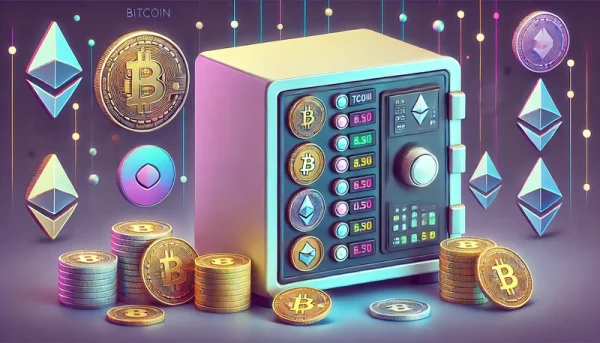What is NFT Staking And How Does It Work
NFT staking transforms digital collecting by letting users earn passive income through dedicated platforms. By locking their NFTs into smart contracts, collectors secure rewards such as tokens and governance assets, while also enjoying exclusive perks like early access to new releases and deeper engagement in virtual communities.
In this article, we explain NFT staking and give more details.
Table of content
How Does NFT Staking Work?
Choose and Verify Your NFT
First, you choose an NFT you own that can be staked. Not all NFTs can be staked, so you must check if yours is eligible. Then, you find a staking platform that supports your NFT. This could be a specialized NFT staking site or a broader DeFi platform.
Connect Your Wallet and Deposit NFT
Next, you connect your cryptocurrency wallet (like MetaMask) to the staking platform. This wallet must contain the NFT you want to stake. Once connected, you deposit your NFT into the platform’s smart contract, sending the NFT from your wallet to the smart contract address. After the transaction is confirmed on the blockchain, your NFT is locked in the contract for a set period.
Earn Rewards and Unstake
While your NFT is staked, you earn rewards. These can be native tokens, governance tokens, other NFTs, or a mix, depending on the platform's rules. You can usually claim your rewards at certain times or at the end of the staking period. When the staking period ends, or if you decide to unstake early (if allowed), you initiate an unstaking process. Your NFT and any unclaimed rewards are returned to your wallet.
Smart Contracts and Blockchain Security
Smart contracts, which are automated and self-executing, manage the staking process. Blockchain technology ensures everything is transparent, secure, and immutable. The smart contract also defines how and when rewards are given out.
For instance, imagine you have a rare NFT from a play-to-earn game. You connect your wallet to the game's NFT staking platform and stake NFT by transferring it to the smart contract. Over time, you earn the game’s native tokens as rewards. After three months, you decides to unstake your NFT and get NFT back along with your rewards.
Remember, there may be fees for staking and unstaking and sometimes a minimum lock-up period. The value of your NFT and rewards can also change with the market. Despite these factors, NFT staking can earn extra income from your NFTs beyond just holding or trading them.
NFT Staking Reward Calculation
Calculating NFT staking rewards typically depends on several factors determined by the platform or project offering the staking program.
Staking Period
The length of time you commit to staking your NFT matters. Longer staking periods often yield higher rewards or better reward rates than shorter periods. Platforms may offer different tiers or rates based on the lock-up duration.
APY (Annual Percentage Yield)
Platforms usually advertise an APY, which represents the annualized rate of return for staking your NFT. This rate can vary widely and is influenced by market conditions, platform policies, and tokenomics factors.
Tokenomics
The economic model of the platform's native token or reward mechanism affects how rewards are distributed. Some platforms distribute rewards in their native tokens, while others might offer a mix of tokens, including governance tokens or other benefits.
Staking Pool Dynamics
The size and activity of the staking pool can impact your rewards. Larger pools might have diluted rewards compared to smaller, more focused pools. Additionally, some platforms adjust rewards based on overall staking participation to maintain ecosystem balance.
Platform Policies and Fees
Platforms may impose fees for staking and unstaking transactions, affecting your net rewards. Consider these fees when evaluating the profitability of staking your NFT.
Compounding Rewards
Some platforms allow for compounding rewards, where earned rewards are automatically reinvested into the staking pool. This can increase your earnings potential over time.
Example Calculation
This is a hypothetical example to illustrate how NFT staking rewards might be calculated:
NFT Staked: A person stakes a rare in-game NFT for a period of 90 days.
Platform APY: The platform advertises an APY of 100% for this specific staking pool.
Initial Value: Assume the NFT a person staked has an initial value equivalent to 100 native tokens (let's call them XYZ tokens).
Calculation:
- Daily Reward Rate: APY/365, gives the daily percentage yield. In this case, 100%/365≈0.274% per day.
- Accumulated Reward: Over 90 days, a person would earn approximately 0.274%×90≈24.66% in rewards.
- Total Value: If the value of XYZ tokens remains stable or appreciates during the staking period, a person’s total value upon unstaking would be her original 100 tokens plus 24.66 tokens in rewards.
The Best NFT's Staking Platforms
Several NFT staking platforms are considered among the best in the industry:
LooksRare
This is a community-focused NFT marketplace that allows you to stake their LOOKS token to earn a portion of the platform's trading fees. You can't directly stake NFTs, but holding staked LOOKS can indirectly benefit your NFT holdings.
- LOOKS token staking, not direct NFT staking.
- Stake your LOOKS tokens to earn a portion of the platform's trading fees.
- LOOKS tokens, potentially increasing the value of your overall NFT portfolio if LOOKS appreciates.
- Supports the LooksRare platform and potentially benefits from its growth.
WhenStaking
This platform offers staking opportunities for various NFT collections across blockchains. You can stake your NFTs to earn rewards in the platform's native token or the underlying NFT blockchain cryptocurrency.
- Staking various NFT collections across blockchains.
- Deposit your NFTs into the platform's staking pool for a chosen duration.
- Can vary depending on the NFT collection. You might earn the platform's native token, the underlying blockchain's crypto (e.g., ETH for Ethereum NFTs), or a combination.
- Earn passive income from your NFTs and potentially gain additional platform benefits.
NFTX
This platform allows fractional ownership of NFTs, meaning you can invest in a portion of an NFT instead of the entire one. They also offer NFT staking, where you can lock up your NFTs (or portions of them) to earn rewards like interest or exclusive access to features.
- Fractional ownership and staking of NFTs.
- Stake your entire NFT or a portion (through fractional ownership) to earn rewards.
- Can vary. You might earn interest-like rewards in the platform's token, exclusive access to features, or in-game benefits (depending on the NFT).
- Earn passive income, potentially amplify returns by staking fractions, and unlock additional features.
Splinterlands
This is a play-to-earn trading card game where you can stake your NFT cards to earn the platform's token (DEC) and other in-game rewards. Staking rarer cards or higher quantities often leads to better rewards.
- Play-to-earn game with NFT card staking.
- Stake your collectible NFT cards within the Splinterlands game.
- Earn Dark Energy Crystals (DEC), the platform's token, which can be used for in-game purchases, trading, or potential conversion to other cryptocurrencies. Rarity and quantity of staked cards influence rewards.
- Earn in-game rewards, potentially increase your earning potential with stronger cards, and contribute to the game's ecosystem.
Top NFT Staking Projects
Find some of the best projects overviewed down below.
The Sandbox
This project lets users explore a user-driven metaverse by acquiring virtual land parcels (NFTs) and unique in-game assets. Staking these LAND NFTs earns rewards in SAND tokens, the platform's cryptocurrency, and rare in-game resources.
- Sandbox Alpha (play-to-earn game) with NFT land and asset ownership.
- Stake LAND NFTs (virtual land plots) to earn SAND tokens (platform currency) and potentially rare resources for use within the game. Rarity and location of LAND can influence rewards.
- Earn passive income, access exclusive in-game benefits, and contribute to developing The Sandbox metaverse.
Axie Infinity
This platform revolves around collecting, breeding, and battling Axies, creatures with unique body parts and abilities. Earning Smooth Love Potions (SLP) is important for breeding and purchases. Staking Axies helps earn SLP and participate in battles, where an Axie's strength directly affects earnings, making it a thriving ecosystem with potential financial rewards.
- Play-to-earn monster battling game with breedable NFT creatures (Axies).
- Stake Axies to earn Smooth Love Potions (SLP), the game's token used for breeding new Axies and in-game purchases. Staking also allows breeding and participating in battles.
- Earn SLP for breeding and gameplay, potentially increase earnings with stronger Axies, and contribute to the Axie Infinity ecosystem.
CyberKongz
This collection features meticulously rendered 3D ape-themed NFTs, fostering a strong community. Owning a CyberKongz NFT, especially a “Genesis Kongz,” gives status in their universe. While initial staking for Genesis Kongz may have ended, ongoing staking updates on their official website offer long-term value and community benefits.
- Collectible NFT project with unique 3D-rendered ape characters.
- Originally offered staking for Genesis Kongz (first 1,000 NFTs) to earn BANANA tokens (platform currency).
- Previously offered passive income through BANANA rewards. Owning a CyberKongz NFT can hold long-term value and potential community benefits.
Mutant Cats
This collection showcases unique digital cat characters with varied traits. Staking opportunities for Mutant Cats can be found on platforms like WhenStaking, offering potential passive income and community perks.
- Collectible NFT project with unique digital cat characters.
- Staking information might be limited or vary depending on partnerships. Platforms like WhenStaking (mentioned earlier) might offer Mutant Cats staking for rewards in their native token or the underlying blockchain's crypto.
- Potential passive income through staking on compatible platforms. Owning a Mutant Cats NFT can hold value and access to community features.
Doge Capital
Appealing to dog enthusiasts, Doge Capital offers dog-themed NFTs that can be staked to earn DAWG tokens. These tokens may be used for in-game purchases or trading. Staking a Doge Capital NFT provides passive income and access to evolving platform features and benefits.
- Collectible NFT project with dog-themed characters.
- Stake Doge Capital NFTs to earn DAWG tokens (platform currency) which can be used for in-game purchases (if applicable) or traded on decentralized exchanges (DEXs).
- Earn DAWG tokens for passive income, potentially gain access to exclusive features or in-game benefits (depending on platform development).
NFT Staking Pros & Cons
Pros
- Staking NFTs can provide a passive income stream through rewards, usually as additional tokens or NFTs.
- By staking NFTs, users can support the ecosystem they are invested in, contributing to its growth and stability.
- Some platforms offer exclusive benefits to stakers, such as early access to new NFT drops or special events.
- Staking encourages users to hold onto their NFTs for longer periods, which can benefit the market's stability.
- Staking can potentially increase the value of your NFTs in two ways. First, by reducing the circulating supply (since staked NFTs are locked up).Second, some staking rewards can be used to enhance your NFT, making it more desirable
- By staking your NFTs, you contribute to the growth and development of the project you believe in.
Cons
- Some staking mechanisms require locking up your NFTs for a certain period, limiting your ability to sell or trade them.
- The value of staked tokens or rewards can be subject to market volatility, which may affect the overall returns.
- Staking on a platform means trusting its security and reliability; if the platform fails or is hacked, you could potentially lose your staked assets.
- Understanding how staking works and managing your staking activities can be complex, especially for newcomers.
- Staking NFTs may tie up your assets in illiquid forms, making it harder to quickly convert them back into cash if needed.
Final Thoughts On NFT Staking
NFT staking enables collectors to earn passive income by locking their NFTs into specialized platforms via smart contracts. This involves selecting eligible NFTs, connecting a wallet, depositing tokens into a smart contract for a set period, and receiving rewards like native or governance tokens.
Platforms such as LooksRare, WhenStaking, NFTX, and Splinterlands offer diverse staking opportunities, each with unique rewards. Projects like The Sandbox, Axie Infinity, CyberKongz, Mutant Cats, and Doge Capital showcase the range of benefits, from earning platform tokens to accessing exclusive in-game rewards.
FAQ About NFT Staking
How much does it cost to stake an NFT?
There isn't a fixed cost, but NFT staking can involve gas fees.
How do you earn money from NFTs?
You can earn rewards like cryptocurrency or increased NFT value.
How to claim NFT staking reward?
The specific claiming process depends on the platform.
Where can you buy NFTs to stake?
You can buy NFTs on marketplaces like OpenSea that support staking.
How to earn passive income staking NFTs?
Staking NFTs locks them up to earn passive income, like interest.
What does staking NFT mean?
It's like depositing an NFT to earn rewards for supporting a project.




![Top 10 Best Crypto Staking Platforms for [year]](https://betoncrypto.io/app/uploads/2024/12/cryptostaking.webp)
![Best Cryptos to Stake in [year]](https://betoncrypto.io/app/uploads/2024/11/image1-4.webp)

